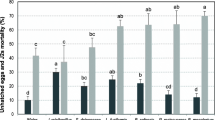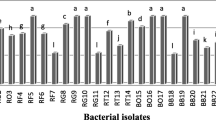Abstract
Trichodorid nematodes (Nematoda: Trichodoridae) are vectors of tobacco rattle virus (TRV), one of the causal agents of spraing disease in potato. Root bacteria from nematicidal plants and their control potential against Trichodoridae were the focus of this study. Bacteria isolated from the roots of 12 nematicidal plants and potato were characterized for their production of hydrolytic enzymes, hydrogen cyanide, phenol oxidation ability and antifungal activity towards the potato pathogen Rhizoctonia solani. Based on these functional traits, bacteria isolates were selected and tested in greenhouse conditions on potato (cv. Saturna) for their effect on plant growth, and screened for nematicidal activity against Paratrichodorus pachydermus and Trichodorus primitivus in naturally infested soil. Sixteen bacteria isolates out of 44 reduced nematode densities by 50–100%. Nine selected isolated were further tested by bacterizing potato tubers (cv. King Edward) which were planted in a trichodorid and TRV-infested soil. Four bacterial isolates consistently reduced nematode densities (by 56.7–74.4%) with no visual negative effect on plant growth. These isolates were tentatively identified, partly by fatty acid methyl ester (FAME) analysis as: Stenotrophomonas maltophilia, Bacillus mycoides, Pseudomonas sp., and one unidentified bacterium. The isolates originated from potato, Plantago major, Thymus vulgaris and Asparagus officinalis, respectively. Two Pseudomonas isolates obtained from Zinnia elegans and selected for their strong nematicidal activity in soil screening tests, did not reduce the nematode population when tested on potato. It is concluded that plants releasing nematicidal compounds may harbour nematode-antagonistic bacteria as well.
Similar content being viewed by others
References
Alström S 2001 Characteristics of bacteria from oilseed rape in relation to their biocontrol activity against Verticillium dahliae. J. Phytopathol. 149, 57–64.
Bansal R K, Dahiya R S, Lakshminarayana K, Suneja S, Anand R C and Narula N 1999 Effects of rhizospheric bacteria on plant growth of wheat infected with Heterodera avenae. Nematol. medit. 27, 311–314.
Becker J O, Zabaleta-Mejía E, Colbert S F, Schroth M N, Weinhold A R, Hancock J G and Van Gundy S D 1988 Effects of rhizobacteria on root-knot nematodes and gall formation. Phytopathology 78, 1466–1469.
Cronin D, Moënne-Loccoz Y, Dunne C and O'Gara F 1997 Inhibition of egg hatch of the potato cyst nematode Globodera rostochiensis by chitinase-producing bacteria. Eur. J. Plant Pathol. 103, 433–440.
Défago G and Haas D 1990 Pseudomonads as antagonists of soil-borne plant pathogens: modes of action and genetic analysis. In Soil Biochemistry, Vol. 6. Eds. J M Bollag and G Stottzky. pp 249–291. Marcel Decker Inc., New York.
Ellenby C 1951 Mustard oil and control of the potato-root eelworm, Heterodera rostochiensis Wollenweber. Further field and laboratory experiments. Ann. Appl. Biol. 38, 859–875.
Galper S, Cohn E, Spiegel Y and Chet I 1990 Nematicidal effect of collagen-amended soil and the influence of protease and collagenase. Revue Nématol. 13 (1), 67–71.
Gommers F J 1981 Biochemical interactions between nematodes and plants and their relevance to control. Helminthol. Abstr. 50, 9–24.
Good J M, Minton N A and Jaworski C A 1965 Relative susceptibility of selected cover crops and coastal bermudagrass to plant nematodes. Phytopathology 55, 1026–1030.
Hackenberg C, Muehlchen A, Forge T and Vrain T 2000 Pseudomonas chlororaphis strain Sm3, bacterial antagonist of Pratylenchus penetrans. J. Nematol. 32 (2), 183–189.
Hasky-Günther K, Hoffmann-Hergarten S and Sikora R A 1998 Resistance against the potato cyst nematode Globodera pallida systematically induced by the rhizobacteria Agrobacterium radiobacter (G12) and Bacillus sphaericus (B43). Fund. Appl. Nematol. 21 (5), 511–517.
Hoffmann-Hergarten S, Gulati M K and Sikora R A 1998 Yield response and biological control of Meloidogyne incognita on lettuce and tomato with rhizobacteria. J. Plant Diseases and Protection 105, 349–358.
Insunza V 1994 Propiedades nematicidas de plantas chilenas. I. Evaluación en bioensayos con tres nematodos fitoparásitos. Fitopatología 29, 44–45.
Insunza V, Aballay E, Macaya J 1998 Acción nematicida de extractos acuosos de 30 plantas en poblaciones chilenas de Xiphinema index y X. americanum sensu lato. Nematropica 28, 134–135.
Insunza V, Alström S and Eriksson B 2000 Root associated bacteria from nematicidal plants and their suppressive effects on trichodorid nematodes in potato. Auburn University Web site, htpp//www.ag.auburn.edu/argentina/pdfmanuscripts/insunza.pdf.
Kloepper J W, Rodríguez-Kabana R, McInroy J A and Collins D J 1991 Analysis of populations and physiological characterization of microorganisms in rhizospheres of plants with antagonistic properties to phytopathogenic nematodes. Plant Soil 136, 95–102.
Kloepper J W, Rodríguez-Kabana R, McInroy A and Young R W 1992 Rhizosphere bacteria antagonistic to soybean cyst (Heterodera glycines) and root-knot (Meloidogyne incognita) nematodes: identification by fatty acid analysis and frequency of biological control activity. Plant Soil 139, 75–84.
Kloepper J W, Rodríguez-Kabana R, Zehnder G W, Murphy J E, Sikora E and Fernandez C 1999 Plant root-bacterial interactions in biological control of soilborne diseases and potential extension to systemic and foliar diseases. Australasian Plant Pathology 28, 21–26.
Kluepfel D A, McInnis T M and Zehr E I 1993 Involvement of root-colonizing bacteria in peach orchard soils suppressive of the nematode Criconomella xenoplax. Phytopathology 83, 1240–1245.
Kumar D, Berggren B S and Mårtensson A M 2001 Potential for improving pea production by co-inoculation with fluorescent Pseudomonas and Rhizobium. Plant Soil 229, 25–34.
Martínez-Ochoa N, Kloepper J W, Rodríguez-Kabana R and Pingsheng J 1997 Induced resistance and phenotypic characteristics of several PGPR compared to biocontrol activity against the root-knot nematode Meloidogyne incognita. In Plant Growth Promoting Rhizobacteria. Present Status and Future Prospects. Eds. A Ogoshi, K Kobayashi, Y Homma, F Kodama, N Kondo and S Akino. pp 296–300. Proceedings of the 4th Int. Workshop on PGPR, Sapporo, Japan, October 1997.
McSorley R, Dickson D W 1995 Effect of tropical rotation crops on Meloidogyne incognita and other plant-parasitic nematodes. J. Nematol. 27 (4) (Supplement), 535–544.
Oostendorp M and Sikora R A 1989 Seed treatment with antagonistic rhizobacteria for the suppression of Heterodera schachtii early infection of sugar beet. Revue Nématol. 12, 77–83.
Persson P and Sletten A 1995 Fatty acid analysis for the identification of Erwinia carotovora subsp. atroseptica and E. carotovora subsp. carotovora. EPPO Bull. 25, 151–156.
Racke J and Sikora R A 1992 Influence of the plant health promoting rhizobacteria Agrobacterium radiobacter and Bacillus sphaericus on Globodera pallida root infection of potato and subsequent plant growth. J. Phytopathol. 134 (3), 198–208.
Rodríguez-Kabana R and Kloepper J W 1998 Cropping systems and the enhancement of microbial activities antagonistic to nematodes. Nematropica 28, 144–145.
Rohde R A and Jenkins W R 1958 The chemical basis of resistance of asparagus to the nematode Trichodorus christiei. Phytopathology 48, 463.
Rydén K, Sandgren M and Hurtado S 1994 Development during storage of spraing symptoms in potato tubers infected with tobacco rattle virus. Potato Research 37, 99–102.
Spiegel Y, Cohn E, Galper S, Sharon E and Chet I 1991 Evaluation of a newly isolated bacterium, Pseudomonas chitinolytica sp. nov., for controlling the root-knot nematode Meloidogyne javanica. Biocontrol Sci. Technol. 1, 115–125.
Takagusi T, Yachida Y, Anetai M, Masamune T and Kegasawa K 1975 Identification of asparagusic acid as a nematicide occurring naturally in the roots of Asparagus. Chem. Lett. 43, 44.
Tian H, Wang S and Wu X 1995 Screening of rhizobacteria antagonistic to plant-parasitic nematodes. Acta Agriculturae Universitatis Pekinensis 21, 209–213.
Tian H, Riggs R D and Crippen D L 2000 Control of soybean cyst nematode by chitinolitic bacteria with chitin substrate. J. Nematol. 32 (4), 370–376.
Weller D M 1988 Biological control of soilborne plant pathogens in the rhizosphere with bacteria. Annu. Rev. Phytopathol. 26, 379–407.
Whitehead A G and Hemming J R 1965 A comparison of some quantitative methods of extracting small vermiforms nematodes from soil. Ann. Appl. Biol. 55, 25–38.
Zehnder G W, Yao C, Murphy J F, Sikora E R and Kloepper W 2000 Induction of resistance in tomato against cucumber mosaic cucumovirus by plant growth-promoting rhizobacteria. BioControl 45, 127–137.
Author information
Authors and Affiliations
Corresponding author
Rights and permissions
About this article
Cite this article
Insunza, V., Alström, S. & Eriksson, K.B. Root bacteria from nematicidal plants and their biocontrol potential against trichodorid nematodes in potato. Plant and Soil 241, 271–278 (2002). https://doi.org/10.1023/A:1016159902759
Issue Date:
DOI: https://doi.org/10.1023/A:1016159902759




